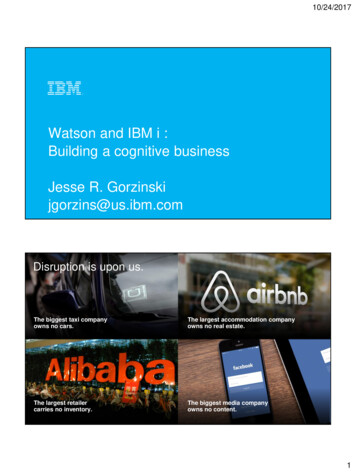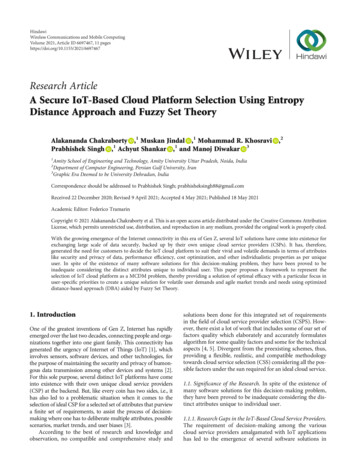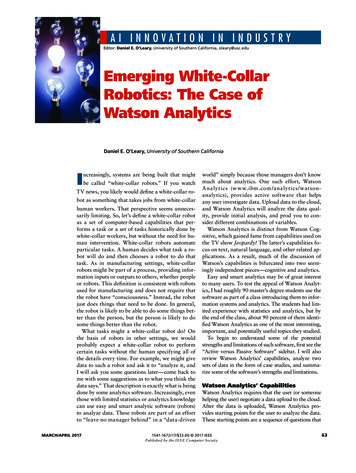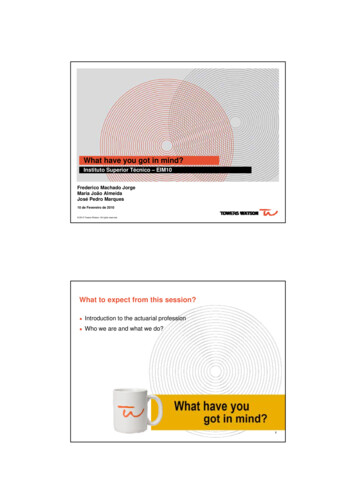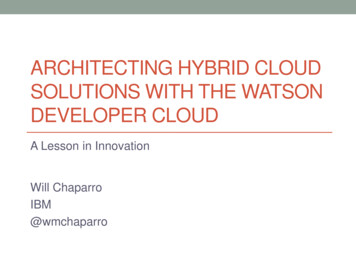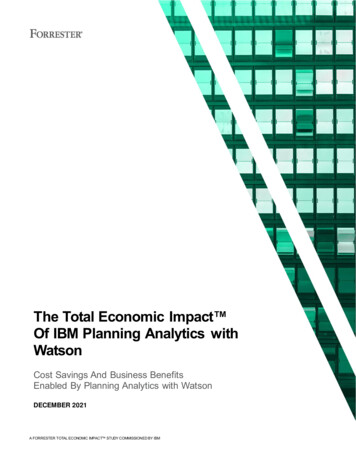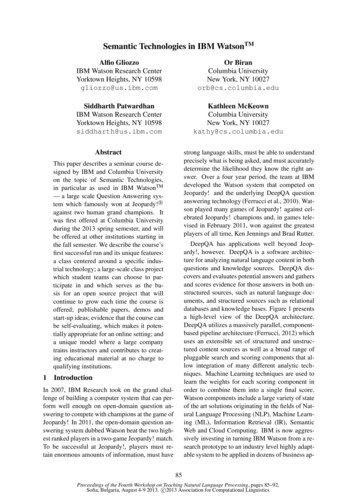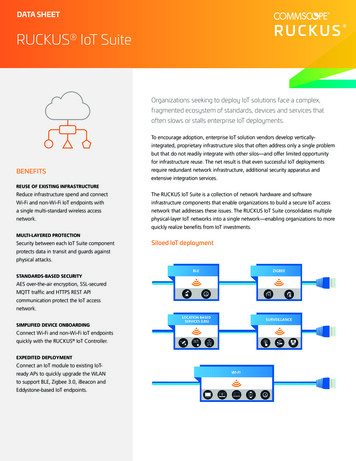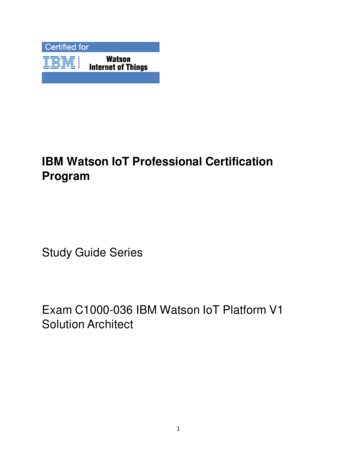
Transcription
IBM Watson IoT Professional CertificationProgramStudy Guide SeriesExam C1000-036 IBM Watson IoT Platform V1Solution Architect1
Purpose of Exam ObjectivesWhen an exam is being developed, the Subject Matter Experts work together to define therole the certified individual will fill. They define all of the tasks and knowledge that anindividual would need to have in order to successfully implement the product. This createsthe foundation for the objectives and measurement criteria, which are the basis for thecertification exam.The Watson IOT Certification item writers used these objectives to develop the questionsthat they wrote, and which will appear on the exam.It is recommended that you review these objectives. Do you know how to complete the taskin the objective? Do you know why that task needs to be done? Do you know what willhappen if you do it incorrectly? If you are not familiar with a task, then go through theobjective and perform that task in your own environment. Read more information on thetask. If there is an objective on a task there is about a 95% chance that you WILL see aquestion about it on the actual exam.After you have reviewed the objectives and completed your own research, then take theassessment exam. While the assessment exam will not tell you which question youanswered incorrectly, it will tell you how you did by section. This will give you a goodindication as to whether you are ready to take the actual exam or if you need to furtherreview the materials.Note: This is the high-level list of objectives. As you review these objectives, you will see a moredetailed level of how to perform the task.2
High-level Exam ObjectivesSection 1 Technical architecture and capabilities of the WIoT Platform1.1 Understand and detail the overall technical capabilities of WIoT Platform1.2 Understand and detail the capabilities of WIoT Platform Connection Service1.3 Understand and detail core capabilities of WIoT Platform Analytics Service1.4 Understand and detail core capabilities of WIoT Platform Blockchain ServiceSection 2 Architectural Patterns2.1 Understand and articulate Industrial IoT2.2 Understand and describe IBM's IoT Industry SolutionsSection 3 Planning WIoT Platform Architecture3.1 Recognizes opportunities performing discovery to define business and technicalrequirements, and key decision makers3.2 Evaluate the customer's environment and maturity level3.3 Evaluate provisioning and cloud topology considerations3.4 Evaluate service level requirements to meet the cost and performance goals for theenvironment3.5 Proposing a high level architecture for early client feedbackSection 4 Design a suitable WIoT Platform Architecture4.1 Identify critical data entities4.2 Design approach for Device Management4.3 Apply requirements for Data Management4.4 Design how analytic services can be exploited to enrich the solution4.5 Design how applications can be integrated with WIoT Platform Services4.6 Summarize validate and present to clientSection 5 Implementation Deployment and Scaling5.1 Describe the principles and phases of solution lifecycle from pilot to production5.2 Develop an appropriate process to take an IoT solution from inception to production5.3 Extend solution to identify and handle typical IoT faults5.4 Develop a strategy to monitor IoT solutions3
Detailed Exam ObjectivesSection 1 - Technical Architecture and capabilities of the WIoT Platform1.1 Understand and detail the overall technical capabilities of WIoT PlatformSUBTASKS:1.1.1Explain core characteristics of an IoT solution, specifically device connectivity, security,data communication, internet routing and protocols, and device management.1.1.2Explain device connectivity and device twins through the Watson IoT ConnectionService.1.1.3Explain data capture through Cloudant NoSQL DB.1.1.4Explain data aggregation and filtration through DB2 Warehouse.1.1.5Explain data archive through Cloud Object Storage.1.1.6Explain capabilities of the Secure Gateway and IBM Event Streams.1.1.7Explain in detail the key differentiators of the Watson IoT Platform1.1.8Explain the end to end security of Watson IoT platform1.1.9Understand integration capabilities with existing systems, current IoT offerings, as wellas WIoT Platform Analytics Service and WIoT Blockchain Service.Reference: Business Partner Hands-On p0y66pjIBM Watson IOT Platform Knowledge /tr/SSQP8H/iot/kc 1.2 Understand and detail the capabilities of WIoT Platform Connection ServiceSUBTASKS:1.2.2.1 Register and connect devices with the IoT Platform1.2.2.2 Manage devices – track their identification and status1.2.2.3 Secure devices – manage security credentials and white/black-list devices1.2.2.4 Capture data from devices and map to a logical data format1.2.2.5 Associate devices with user and organization ownership1.2.2.6 Process data by storing in data stores and making available for analysis and access byapplications1.2.2.7 Archive data for long-term storage (at low cost)1.2.2.8 Data lifecycle and retention durationsReference:IBM Watson IOT Platform Knowledge /tr/SSQP8H/iot/kc welcome.html1.3 Understand and detail core capabilities of WIoT Platform Analytics Service4
Understand the capabilities of WIoTP Analytics Service that can be applied to addressrequirements in an IoT solution to link IoT data with the Analytics ServiceSUBTASKS:1.3.1 Review the customer’s requirements & usecase1.3.2 Explain the overall capability of Analytics Service1.3.3 Assess data requirements for device and other data sources supporting the usecase1.3.3 Feed sample data from device and other sources to Analytics Service1.3.4 Explore and verify quality of input data1.3.5 Apply basic transformation to data using standard built-in function1.3.6 Understand how to develop custom function using Analytics Service API1.3.5 Assess and map customer outcomes to list of custom functionsReference:Overview - https://ibm.box.com/v/WatsonIoTAnalyticsKnowledge /SSQP8H/iot/analytics/as getting started.htmlTechnical deep dive:Deck: 8rcjRecording: 8nqk1.4: Understand and detail core capabilities of WIoT Platform Blockchain g IoT and Asset Data to business criteriaEnriching IoT data with business data to provide context for IoT data pointsManaging Blockchain Credentials and ConnectionAssociate IoT devices with Blockchain Smart owledgecenter/en/SSCG66/iotblockchain/kc /trending/blockchain5
Section 2 - Architectural Patterns2.1 Understand and articulate Industrial IoTSUBTASKS:2.1.1 Understand the characteristics and trends around Industry 4.02.1.2 Understand integration with enterprise management systems2.1.3 Understand integration with third party platforms2.1.4 Understand the characteristics and trends around edge processing2.1.5 Understand the characteristics around Digital TwinReference: Aberdeen Group report: htmlfid WWL12382USENReference: https://www.ibm.com/internet-of-thingsReference: gital-twinReference:https://www.ibm.com/search?q industrial iot&lnk mhsrch&v 18&en utf&lang en&cc usReference: try-4-guide2.2 Understand and describe IBM's IoT Industry SolutionsSUBTASKS:2.2.1 Understanding IBM IoT Building Insights and TRIRIGA IntegrationReference: /content/K460956R87252Y06.html#indexb2.2.2 Understanding IBM Asset Performance Management (APM) SolutionsReference: mentReference: welcome.html2.2.2.1 Understanding Maximo APM Equipment Maintenance AssistantReference: intenance-assistant2.2.2.2 Understanding Maximo APM - Asset Health InsightsReference: https://www.ibm.com/products/maximo/add-ons2.2.2.3 Understanding Maximo APM for Energy and t4eu.html2.2.3.4 Understanding IBM Production Quality Insights & Production OptimizationReference: .2.4 Understanding IBM Worker InsightsReference: rkplace6
Section 3 - Planning WIoT Platform architecture3.1: Recognizes opportunities performing discovery to define business and technicalrequirements, and key decision makersSUBTASKS:3.1.1 Understand and deliver core concepts of a discovery workshop from workshop from adesign thinking perspective3.1.2 Identify key use case or business problem3.1.3 Define functional and technical requirements based off of use case, priorities and currentassets3.1.4 Identify key decision makers3.1.5 Compare client use cases with reference blueprints to identify re-use opportunities3.2 Evaluate the customer's environment and maturity levelSUBTASKS:3.2.1. Identify client's existing business Application environment3.2.2. Identify client's Infrastructure dependencies3.2.3. Evaluate maturity level of customer in terms of skill technology and use3.2.4. Evaluate maturity level of customer in terms of IoT data use3.2.5. Determine connectivity and messaging capabilities – sensors/devices/gateways3.2.5.1 Determine connection protocols3.2.5.2 Evaluate connection level security3.2.5.3 Determine messaging protocols3.2.5.4 Evaluate messaging layer security3.2.6 Determine data lifecycle capabilities - how do they store IoT data today, what data lakesdo they use, can they consolidate3.2.7. Determine analytics capabilities - can they use analytics to get better understanding oftheir IoT data3.2.8. Determine opportunities for Blockchain3.2.9. Determine opportunities for cs/services/IoT/reference/standards and requirements.html#standards and otas.html#quotas7
3.3 : Evaluate provisioning and cloud topology considerationsSUBTASKS:3.3.1 Understand public, and private cloud3.3.2 Understand IBM Public and Dedicated Cloud offerings [is Dedicated even worthreferencing as it is not a supported option for IoTP?]3.3.3 Understand IBM Cloud Private3.3.4 Review client's network topology and application dependencies3.3.5 Evaluate provisioning considerations - IBM Public vs Dedicated vs ICP vs H3.4: Evaluate service level requirements to meet the cost and performance goals for theenvironmentUnderstand the capacity and pricing structure for the WIoTP Connection Service, AnalyticsService and Blockchain Service. Map the customer’s requirements onto the most appropriatedevice type option for IoT Platform Connection Service. Calculate the capacity required for theIoT Platform services required for the solution.SUBTASKS:3.4.1 Identify the production environment requirements of the solution in terms of3.4.4.1 Number of devices to be connected – sensors and gateways3.4.4.2 Frequency and size(s) of messages ingested by IoTPCS3.4.4.3 Message frequency and message size determine IoTPCS device type3.4.4.4 Growth forecast for devices3.4.2 Identify additional data sources and requirements to ingest data into the IoT Platform3.4.3 Identify data retention requirements3.4.4 Identify analytics requirements for production environment:3.4.4.1 Frequency of analytical function calculation3.4.4.2 Number of analytical functions to be calculated per device3.4.5 Calculate total data storage3.4.6 Identify Blockchain requirements for production environment:3.4.6.1 Frequency of transactions per device to be shared on a Blockchain3.4.7 Identify requirements for non-production instances for development and test usage3.4.8 Evaluate whether requirements meet the environment cost and performance goals3.4.9 Perform cost and performance trade off analysis3.4.10 Review trade off analysis with htmlReference: c6b9fa8039c86256c6800578854/c6 e4fc3fd851e7d2862581e60049c873/ FILE/i126-7779-02 11-2017 en US.pdf8
3.5 Proposing a high level architecture for early client feedbackSUBTASKS:3.5.1 Define architecture and related considerations3.5.2. Identify where functional requirements have been considered/included in the proposedsolution design3.5.4. Summarize and present solutions to customer9
Section 4 - Design a suitable WIoT Platform Architecture4.1 Identify critical data entitiesSUBTASKS:4.1.1 Gather device information and pay load details from IoT devices4.1.2 Analyze and define data into WIoTP data format4.1.3 Identify data required for historical view4.1.4 Identify data for normalization4.1.5 Identify data for monitoring and management actions4.2: Design approach for Device ManagementSUBTASKS:4.2.1 Identify requirements for device connectivity and authentication.4.2.1.1 Determine which devices will connect directly, which will connect through agateway, which will connect via 3rd party platforms.4.2.1.2 Determine how the gateways or directly-connected devices are going toauthenticate (token or PKI) with WIoTP4.2.1.3 Determine how the gateways or directly-connected devices are going to beprovisioned with the authentication credentials that they will need.4.2.2 Identify requirements for device monitoring and diagnostics.4.2.2.1 Determine the processes for device troubleshooting. What diagnosticinformation do the devices provide?4.2.3 Identify requirements for device software maintenance and updates.4.2.3.1 Define a mechanism for updating the firmware on the devices/gateways. Willthe firmware updates be driven via Watson IoT Platform, or via some other mechanism?4.2.3.2 Identify firmware update server4.2.3.3 Identify the requirements for scheduling firmware update. Are the specific timeswhen update on a device can be performed? Are there constraints involving updates ofmultiple devices (e.g. don't update B while A is being updated)4.2.4 Understand who is going to be responsible for device management. Is it going to beperformed in-house or outsourced?4.2.5 Determine whether the devices are going to need WIoTP management agents installedon 8H/iot/platform/reference/security/connectdevices apps /SSQP8H/iot/platform/devices/device mgmt/index.html10
4.3 Apply requirements for Data ManagementSUBTASKS:4.3.1 Create device types and register devices/gateways within the Watson IoT PlatformService.4.3.2 Ensure devices are connected and data is being sent to the Watson IoT PlatformService.4.3.3 Create a physical and logical interface within the Watson IoT Platform Service.4.3.4 Check to see if data was sent to Cloudant NoSQL DB4.3.5 Find your device type within DB2 Warehouse and create a table of your data.4.3.6 Understand the capabilities of Cloud Object Storage.4.3.7 Understand data is available for 30 days within Cloudant, 90 days within DB2, and 1year within Cloud Object Storage.4.3.8 Understand that the Secure Gateway service allows for secure connection betwe enyour existing on-premise or third-party services to the IBM Cloud.4.3.9 Understand that Event Streams enables streaming of data to analytics applications.4.4 Design how analytic services can be exploited to enrich the solutionSUBTASKS:4.4.1 Assess and map customer outcomes to list of custom functions4.4.2 Configure local Python or Watson development environment with sample Jupyternotebook4.4.3 Develop, register and publish the custom analytic function4.4.4 Apply & score with the new function on the input stream and verify output4.5 Design how applications can be integrated with WIoT Platform ServicesSUBTASKS:4.5.1 Identify the IBM Cloud Services that are currently integrated with the platform.4.5.2. Evaluate tradeoffs between different points of application interaction (e.g., live MQTT vsEvent Streams/Cloudant, COS, DB2) and decide how any user applications will receivemessage data from the platform.4.5.3 Design how the solution will send commands to devices.4.5.4 Identify the APIs to be used for device management.4.5.5 Describe how applications will monitor and respond to (monitoring?) events in theplatform4.6: Summarize validate and present to clientSUBTASKS:4.6.1 Summarize and document the final solution design4.6.2 Identify where functional requirements have been considered/included in the proposeddesign solution.4.6. Present to client11
Section 5 - Implementation Deployment and Scaling5.1 Describe the principles and phases of solution lifecycle from pilot to productionSUBTASKS:5.1.1 Describe the characteristics of a pilot IoT solution5.1.2 Describe the characteristics of a development/test environment5.1.3 Describe the characteristics of a production environment5.1.4 Address the challenges in maintaining and improving your IoT real-estate: remote devicecode changes5.1.5 Address the challenges in maintaining and improving your IoT real-estate: testing androlling out updatesReference:It’s important to recognize challenges for updating device code remotely (e.g., using devicemanagement capabilities in IoTP). Need to recognize that updates to device code may notoccur at the same time, so it’s important to have business logic that handles old and newdevices.5.2 Develop an appropriate process to take an IoT solution from inception to productionSUBTASKS:5.2.1 Explain how an IoT solution can be prototyped cost-effectively and quickly in WIoTPusing collateral including recipes and device simulators5.2.2 Describe how two IoT Platform service instances can be used to construct adevelop/test/production pipeline using different IoTP price plans5.2.3 Define the touchpoints in your device and business application logic that allow switchingbetween the different IoTP environments5.2.4 Implement a test plan to cover appropriate testing of your IoT solution5.2.5 Implement a rollout mechanism to push your changes to your IoT real estate (for initialdeployment and making future updates)5.2.6 Explain how the IoT solution will dovetail with your existing processes (e.g., upport/knowledgecenter/SSQP8H/iot/platform/getting form er/SSQP8H/iot/platform/devices/device r/SSQP8H/iot/platform/developer doc center/SSQP8H/iot/platform/reference/back up.html5.3 Extend solution to identify and handle typical IoT faults12
SUBTASKS:5.3.1 Identify characteristic fault problems met in IoT solutions where do we say 'write yourcode according to best practice, e.g. understand IoTP connection throttling' 5.3.2 Describe how Watson IoT Platform’s APIs can be used to self -diagnose connectivityissues, and best practices on how these can be used at scale5.3.3 Describe how Watson IoT Platform’s monitoring topic can be used to self -diagnosefaults, and best practices on how this can be used at scale5.3.4 Describe how Watson IoT Platform’s device management capability provides amechanism for devices to publish fault information, and best practices on how this can be usedat scale5.3.5 Identify development/test capabilities to maximizing the potential for your solution totolerate typical latform/ts inde SSQP8H/iot/platform/reference/security/client enter/SSQP8H/iot/platform/applications/api.html5.4 Develop a strategy to monitor IoT solutionsSUBTASKS:5.4.1 Describe how monitoring can be used to be alerted to problems quickly5.4.2 Describe how a simple monitoring application can confirm basic device connectivity5.4.3 Describe how a monitoring application can pick up live problems with your IoT solutionby subscribing to the monitor topic5.4.4 Explain how to make your monitoring solution fit for scale – and the pitfalls of not edgecenter/SSQP8H/iot/platform/getting started/getting started-iot-monitoring.html13
Next Steps1. Take the IBM Watson IoT Platform V1 Solutions Architect assessment test.2. If you pass the assessment exam, visit pearsonvue.com/ibm to schedule your testingsessions.3. If you failed the assessment exam, review how you did by section. Focus attention on thesections where you need improvement. Keep in mind that you can take the assessment examas many times as you would like ( 30 per exam), however, you will still receive the samequestions only in a different order.14
3 High-level Exam Objectives Section 1 Technical architecture and capabilities of the WIoT Platform 1.1 Understand and detail the overall technical capabilities of WIoT Platform 1.2 Understand and detail the capabilities of WIoT Platform Connection Service 1.3 Understand and detail core capabilities of WIoT Platform Analytics Service 1.4 Understand and detail core capabilities of WIoT Platform .

